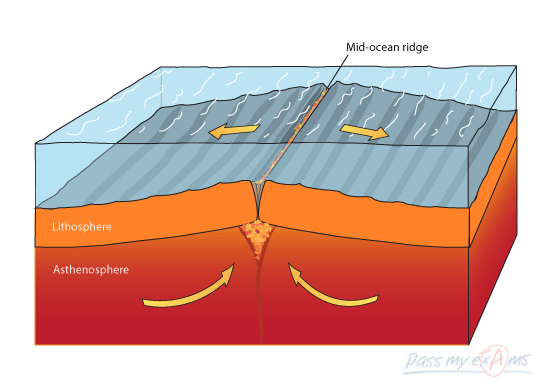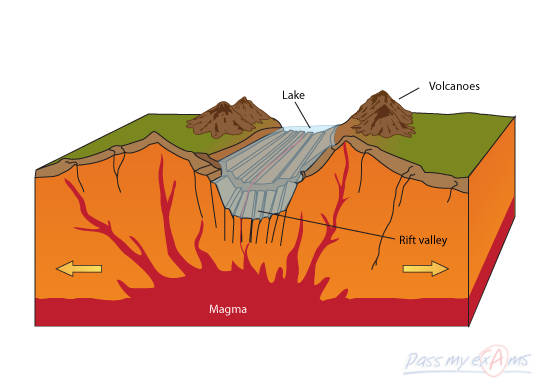Tectonic Plate Motion
Divergent Boundaries
Divergent boundaries are the zones where two tectonic plates are moving away from one another. Divergent boundaries are constructive boundaries because new crust is generated by magma pushing up from the mantle as the plates pull away from each other.
Seafloor Spreading
Divergent boundaries in the middle of the oceans cause seafloor spreading. As the oceanic plates move apart they produce cracks in the ocean floor. Magma rises up from the mantle and oozes out from the cracks like a long, thin undersea volcano. This magma cools to form a new crust of igneous rock. Overtime the cooling magma piles up to form a raised ridge called a mid-ocean ridge. The rate of seafloor spreading depends on the mid-oceanic ridge and can vary from 1 to 20 centimetres per year.
An example of a mid-ocean ridge is the Mid-Atlantic Ridge which extends from the Arctic Ocean to the southern tip of Africa. The rate of sea floor spreading in the Mid-Atlantic Ridge averages about 2.5 centimetres per year. This is equivalent to 25 kilometres in a million years and as this process has been going on for millions of years it has resulted in the Atlantic Ocean growing from a tiny water inlet between Europe, Africa and America to the vast ocean it is today.

Proof of seafloor spreading can be found in the magnetism patterns recorded in ocean floors. The magma from the mantle that oozes out from the mid-oceanic ridge contains atoms of iron. These atoms align themselves to the Earth’s magnetic field and when the magma solidifies to form new crust, the iron atoms lock into position. The solid crust flows away from the mid-oceanic ridge in both directions carrying with it the original magnetic orientation. Over time the Earth’s magnetic field reverses so new crust forming along the ridge takes on the new orientation. As the crust feeds steadily and symmetrically away from the mid-oceanic ridge and the Earth’s magnetic field reverses over and over again a symmetrical striped pattern is created in the ocean floor.
Rift Valleys
Continental and continental plate divergence results in the formations of rifts. A rift is a dropped zone at the point where the plates are moving apart. As the plates move apart the crust widens and thins, valley and volcanoes begin to form in and around the area. At the start of the rift formation streams and rivers flow into the low valley and long lakes can be created. Eventually, the widening crust along boundary may become so thin that a piece of continent can break off to form a new tectonic plate. When this happens water from an ocean can rush in to form a new sea or ocean basin in the rift zone. An example of this can be seen in East Africa where the Arabian plate is moving away from the African plate. This has resulted in Saudi Arabia being torn away from the rest of Africa and the formation of the Red Sea.

